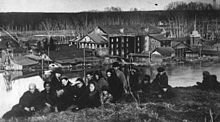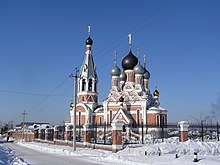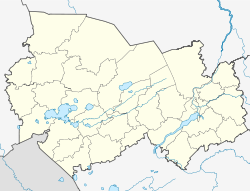Berdsk
hideThis article has multiple issues. Please help or discuss these issues on the talk page. (Learn how and when to remove these template messages)
|
Berdsk
Бердск | |
|---|---|
Town[1] | |
 Panorama of Berdsk | |
 Flag  Coat of arms | |
show Location of Berdsk | |
 Berdsk Location of Berdsk | |
| Coordinates: 54°45′N 83°06′E / 54.750°N 83.100°ECoordinates: 54°45′N 83°06′E / 54.750°N 83.100°E | |
| Country | Russia |
| Federal subject | Novosibirsk Oblast |
| Founded | 1716 |
| Town status since | 1944 |
| Government | |
| • Head | Ilya Potapov |
| Elevation | 130 m (430 ft) |
| Population | |
| • Total | 97,296 |
| • Estimate (2018)[3] | 103,578 (+6.5%) |
| • Rank | 175th in 2010 |
Administrative status | |
| • Subordinated to | Town of Berdsk[1] |
| • Capital of | Town of Berdsk[1] |
Municipal status | |
| • Urban okrug | Berdsk Urban Okrug[4] |
| • Capital of | Berdsk Urban Okrug[4] |
| Time zone | UTC+7 (MSK+4 |
| Postal code(s)[6] | |
| Dialing code(s) | +7 38341 |
| OKTMO ID | 50708000001 |
| Town Day | During the first decade of September |
| Website | www |
Berdsk (Russian: Бердск) is a town in Novosibirsk Oblast, Russia, a suburb of Novosibirsk, situated on a bank of the Berd River. Population: 97,296 (2010 Census);[2] 88,445 (2002 Census);[7] 79,252 (1989 Census).[8]
Geography[]
The town is situated on the left bank of Berdsk gulf, the flooded valley of the Berd River. There are fields to the south of the town and a pine forest of about 20 square kilometers (7.7 sq mi) to the west, between Berdsk and the Ob Sea.
History[]


The migration of Russians into the territory of modern Novosibirsk Oblast began at the end of the 17th century and continued through the beginning of the 18th century. The people were usual for the Siberian colonization: fugitive peasants who escaped from excessive pressure of Peter the Great's regime, Old Believers (raskolniki), or people free for various reasons (volnitsa) like hunters in search of furs attracted by the richness of Siberian woods and others, searching for freedom (volya) and wishing to settle in these places (see History of Siberia).
By 1715, the Berd River basin was significantly populated for the time. The risk of incursions of nomads from the south caused them to demand the Tomsk district authorities build a fortress for defense
In 1716, an expedition left Tomsk and came to the place between the Ob River and its confluent the Berd.[citation needed] The construction was led by , a captive Pole, who settled in Russia, became a serviceman and went to Siberia. A fortress was built in the angle between the two rivers. It was protected by the rivers and precipitous banks from two sides and by a dense forest on the third side. The Ob River valley was able to be observed too from the height of the banks.
The exact date of 1716 is discussed though. Some researches point to earlier mentions of this fortress. In this place there was a duty road that led to Kuznetsk (nowadays Novokuznetsk) town yet in the middle of the 17th century. This place could be ideal for a settlement, and some proofs are given by this version supporters. According to them, the fact that in maps of 1710 there was no settlement in place of Berdsk ostrog could mean that it had been destroyed by nomads.
A description from 1734 reads: "There is one wall in arc between Ob and Berd, of cleaned logs with sharp tops, 3 sazhen high (6.39 m/21'). In front of the wall, there is a ditch with water and some defensive devices. By the ends of the wall there are observation towers. All the buildings are inside of the ostrog: living houses, the church, the chief's house, the courthouse, barns and the garrison. The troop consists of local cossacks having guns, there is one small cannon."
Besides the settled Russians who had to farm to live, the state encouraged the servicemen to farm too. They cultivated the land not far from the fortress, constructing temporary houses and farmsteads (in Russian called заи́мки zaímkas).
In 1730, the Siberian trakt (road) passed here, giving an impulse to the development of trade and crafts.
In the beginning of the 19th century in Berdsk area were found grains of gold washed there from the upper course of the Berd, in particular from some sources at , in 200 km from there. The discovery led to searches and mining of gold in those places.
By the beginning of 20th century Berdsk became a major center of grain processing, refining grain from the upper Ob basin, which nowadays is south of Novosibirsk Oblast and Altai Krai. The industry was highly developed and possessed advanced technologies.
For example, a mill of a merchant V. A. Gorokhov was a significant factory of grain processing, one of the most advanced enterprises in Tomsk Governorate. It was given equipment as advanced as in Western Europe. It could operate ninety tonnes of grain in a day, producing flour of several sorts. The flour was packed into special labelled bags and sold all over Siberia, exported into the European Russia and even to Western Europe. Gorokhov undertook expeditions to trade flour via the Kara Sea where his barge met English merchants. In 1909, Gorokhov's mill won a minor gold medal at the World Fair in Paris. His enterprise was highly developed not only technically and economically, but also socially. The community of the mill personnel lived in a quarter of good and clean houses. They were not only paid well and given gifts for holidays, but also Gorokhov kept a house of culture with stage and professional actors, a library and a well-equipped technical school, to teach all the skills needed to work at the mill, including towboat navigation.
In 1915, passed near Berdsk, it connected Novo-Nikolaevsk, Barnaul and Biysk.
The full mobilization during the World War I and the Civil War after the revolution heavily struck the town: its population diminished by 1/3. During the Civil War it was a place of military command and administrative center of the White movement and also a place of strong resistance of underground communists. The following collectivization was another serious strike, given that the only kind of farmers in Siberia were private independent owners. Even if not many were subjected to repression, the radical change of the relationships ended the role of Siberia as an agricultural exporter.
Town status was granted to Berdsk in 1944.[citation needed]
Because of the construction of the Novosibirsk hydroelectric power station, the main part of the town turned out to be in the of flooding of the Ob Sea. In several years before the filling of the water reservoir in 1957–1958, the town was evacuated and rebuilt around that part near the railroad station. The state provided financial aid to inhabitants. There are no historic buildings left in Berdsk, the oldest were built by 1915 for the station, and the town streets form straight rectangles. However, they are wider than they were before, and the rebuilding also doubled the average living space per capita.
Berdsk was home to a Soviet bioweapons production facility.[9]
On April 7, 2011, Berdsk elected its first Communist Mayor, Ilya Potapov of the CPRF.
Administrative and municipal status[]
Within the framework of administrative divisions, it is incorporated as the Town of Berdsk[1]—an administrative unit with the status equal to that of the districts.[citation needed] As a municipal division, the Town of Berdsk is incorporated as Berdsk Urban Okrug.[4]
Structure and population[]
The town is divided into seven microdistricts. About one third of the town square are private one-floor small houses. They have only cold water, electricity and wired radio. Another third consists of quarters of municipal houses or recently built commercial. Some quarters possess cable TV networks and computer LANs.
Population statistics:
|
(Sources: [1] [2][permanent dead link])
Transportation[]
The road M52 passes through Berdsk connecting Novosibirsk with Altai Krai, Altai Republic and Mongolia. Thanks to it, 15–20 minutes are enough to reach Akademgorodok and about 1 hour to main part of Novosibirsk. The daily commuter traffic to workplaces in the latter two places is significant.
Inside of the town there is a network of municipal and private buses routes, including intercity routes to Novosibirsk and Iskitim. In the central part of Berdsk is situated the railway station with branch lines connecting some local enterprises. The station serves local elektrichkas and transit long distance trains to Altai and Kazakhstan.
River passenger or cargo traffic is only private and negligible, though there is a yacht-club and a pier for sand carrying barges.
Economy[]
Industry[]
Education and culture[]
This article needs additional citations for verification. (July 2007) |

There are about fifteen high schools in Berdsk—the last one was rebuilt in the 1990s, four trade schools, a secondary school, a lyceum, a management college, a medical secondary school, and several libraries.
Berdsk has two palaces of culture: one in the central district and another one in the Mikrorayon micro district. There are three stadiums, five sports schools, a musical school, a museum of history and culture, a park, and a yacht club.
Students normally enroll in public school at age seven and graduate eleven years later. Classes are about 40 minutes long. The school day begins at about 8:00 and ends between 12:00 and 14:00 depending upon the age of the student. Many students augment their public school education by attending private specialized schools after the public school day is complete. Such schools may offer additional training in language, art, or technology. School no.7 (shown in the photo) is one of the smaller schools. It is the location of a Russian-American Summer School. This three-week program is taught by volunteer teachers from the United States, public school no.7 and the Terra Lingua Language School.
Ecology[]
Berd Spit is a city park in Berdsk. It is a specially protected natural area since 2006.[10]
References[]
Notes[]
- ^ Jump up to: a b c d Государственный комитет Российской Федерации по статистике. Комитет Российской Федерации по стандартизации, метрологии и сертификации. №ОК 019-95 1 января 1997 г. «Общероссийский классификатор объектов административно-территориального деления. Код 50 408», в ред. изменения №278/2015 от 1 января 2016 г.. (State Statistics Committee of the Russian Federation. Committee of the Russian Federation on Standardization, Metrology, and Certification. #OK 019-95 January 1, 1997 Russian Classification of Objects of Administrative Division (OKATO). Code 50 408, as amended by the Amendment #278/2015 of January 1, 2016. ).
- ^ Jump up to: a b Russian Federal State Statistics Service (2011). Всероссийская перепись населения 2010 года. Том 1 [2010 All-Russian Population Census, vol. 1]. Всероссийская перепись населения 2010 года [2010 All-Russia Population Census] (in Russian). Federal State Statistics Service.
- ^ "26. Численность постоянного населения Российской Федерации по муниципальным образованиям на 1 января 2018 года". Federal State Statistics Service. Retrieved January 23, 2019.
- ^ Jump up to: a b c Law #200-OZ
- ^ "Об исчислении времени". Официальный интернет-портал правовой информации (in Russian). June 3, 2011. Retrieved January 19, 2019.
- ^ Почта России. Информационно-вычислительный центр ОАСУ РПО. (Russian Post). Поиск объектов почтовой связи (Postal Objects Search) (in Russian)
- ^ Russian Federal State Statistics Service (May 21, 2004). Численность населения России, субъектов Российской Федерации в составе федеральных округов, районов, городских поселений, сельских населённых пунктов – районных центров и сельских населённых пунктов с населением 3 тысячи и более человек [Population of Russia, Its Federal Districts, Federal Subjects, Districts, Urban Localities, Rural Localities—Administrative Centers, and Rural Localities with Population of Over 3,000] (XLS). Всероссийская перепись населения 2002 года [All-Russia Population Census of 2002] (in Russian).
- ^ Всесоюзная перепись населения 1989 г. Численность наличного населения союзных и автономных республик, автономных областей и округов, краёв, областей, районов, городских поселений и сёл-райцентров [All Union Population Census of 1989: Present Population of Union and Autonomous Republics, Autonomous Oblasts and Okrugs, Krais, Oblasts, Districts, Urban Settlements, and Villages Serving as District Administrative Centers]. Всесоюзная перепись населения 1989 года [All-Union Population Census of 1989] (in Russian). Институт демографии Национального исследовательского университета: Высшая школа экономики [Institute of Demography at the National Research University: Higher School of Economics]. 1989 – via Demoscope Weekly.
- ^ Rao, Jason (December 6, 2012). "From Berdsk to Burma: Lessons (and Adventures) in Global Health Diplomacy". Science & Diplomacy. 1 (4).
- ^ Городской парк Бердская коса города Бердска. ООПТ России.
Sources[]
- Новосибирский областной Совет депутатов. Закон №200-ОЗ от 2 июня 2004 г. «О статусе и границах муниципальных образований Новосибирской области», в ред. Закона №548-ОЗ от 29 апреля 2015 г. «Об упразднении посёлка Ивановка муниципального образования Чувашинского сельсовета Северного района Новосибирской области и о внесении изменения в статью 4 Закона Новосибирской области "О статусе и границах муниципальных образований Новосибирской области"». Вступил в силу через 10 дней со дня официального опубликования. Опубликован: "Советская Сибирь", №108, 9 июня 2004 г. (Novosibirsk Oblast Council of Deputies. Law #200-OZ of June 2, 2004 On the Status and the Borders of the Municipal Formations of Novosibirsk Oblast, as amended by the Law #548-OZ of April 29, 2015 On Abolishing the Settlement of Ivanovka in the Municipal Formation of Chuvashinsky Selsoviet of Severny District of Novosibirsk Oblast and on Amending Article 4 of the Law of Novosibirsk Oblast "On the Status and the Borders of the Municipal Formations of Novosibirsk Oblast". Effective as of after 10 days from the day of the official publication.).
- "Moy Gorod" Encyclopedia (in Russian)
- Historical review at Berdsk.ru
- "Berd Ostrog" at the Novosibirsk Oblast portal
External links[]
- Official website of Berdsk (in Russian)
- Berdsk Business Directory (in Russian)
- Berdsk in the electronic map "Dubl-GIS Novosibirsk"
- Pictures of Berdsk
- Berdsk
- Populated places established in 1716
- Tomsk Governorate


